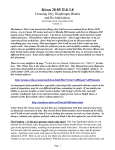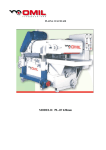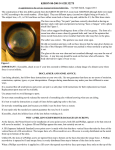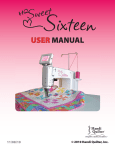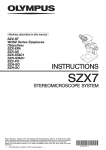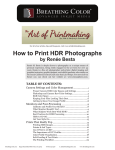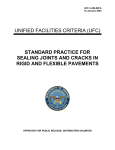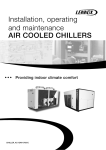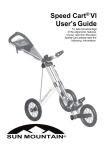Download Kiron 28-105 oily diaphragm blades fix
Transcript
Kiron 28-105 f3.2-4.5 Cleaning Oily Diaphragm Blades and Lens Re-lubrication on Three Particular Lenses. By Prentice Fish, November 2010 version 1.1 Disclaimers: Here I am merely describing what I did on three manual focus Kiron 28-105 lenses, two in Canon FD mount and one in Minolta MD mount, and also one “parts lens” in Nikon mount. I do this as a personal hobby and I lack lens repair skills/experience. What follows reflects that perspective – this is not written for, or by, an experienced lens technician. Don’t hold me responsible if you try this procedure and something goes very wrong. That may happen. Don’t call me and I don’t want any lens repair work. You assume all risks for whatever you do, and carefully consider consulting others who are qualified and experienced. Also keep in mind that Kino Precision (Kiron was their brand name) probably made changes over time when producing this lens, so my lenses may be different from yours. My lenses were four (one being a “parts lens”) serial number *68***** models; said to be the later models. Even the *68***** models varied over time as Kino made lens production changes. The earlier serial number *63***** models are said to be different and more difficult to repair. Kiron produced a 56 page “Parts/Service Manual, Publication Number PL630” for this lens. This Manual has parts diagrams, parts lists, disassembly procedures, and re-assembly procedures. Very helpful. Study it. As of November 2010, you can download this complete Kiron manual, from the helpful Kiron Klub, and Boggy, at this website: http://www.boggys.co.uk/page21.html If you get into trouble, or don’t want to bother with trying to fix the lens yourself, consider sending the lens to an experienced lens repair person such as Ralph Innes, a member of the Kiron Klub, whose website address is: http://members.shaw.ca/f35mru20458/index.html I don’t know Mr. Innes, have not met him nor communicated with him, and of course have no financial connection to him. But several Kiron Klub members have mentioned his skills, and I’d talk to and consider him if I were looking for someone to work on a lens of mine. As always, evaluate your options and pick what you think is the best option for you at the time. The Problem – Is the lens aperture stuck wide open? Oily lens diaphragm blades are not unusual for old lenses, since the grease used on these lenses breaks down over the years, and gets on the aperture blades, resulting in an aperture stuck wide open. Such was the case with my four Kiron 28-105 f3.2-4.5 lenses that I obtained in 2010. Here is one way to test (there are other test methods you may prefer) whether or not your lens has this problem: With the lens in a camera, open the camera back, put the shutter on B shutter setting, and set the f-stop wide open. Cock the shutter, look through the open camera back and the lens, press and hold down Page 1 the shutter, and observe the size of lens opening in the “wide open” lens. Now release the shutter, and change the f-stop to (say) f16. Cock the shutter again, press and hold the shutter down, and look through the camera back and lens again, just like before. If everything is okay, you should see a much smaller opening in the lens. But if the diaphragm remains wide open – the same size as at the f3.5 setting you tried first – the aperture is not “stopping down” as it should, and oily shutter blades may be the problem. You may also see the opening slowly get smaller as you hold the shutter down. If this happens, the aperture is not “stopping down” quickly as it should, and oily shutter blades may be the problem. The photo left shows an example of oily aperture blades on a Kiron 28-105. The diaphragm assembly (that is the part in hand in this photo) can be removed and the oily aperture blades cleaned by disassembling only the front part of the lens. While that would fix the oily blade problem at least temporarily, this limited fix would leave the old grease/oil in the rear part of the lens and ready, perhaps, to migrate again onto the aperture blades, or onto the glass surfaces, leaving an oily haze on the glass. And on my lenses the zoom/focus movement was very poor – mostly loose and sloppy, but overly stiff in a few areas. The likely cause was old lubricant breakdown, also the likely cause of oily aperture blades. So I decided to take apart both the front and rear parts of the lenses, clean the oily aperture blades, clean any oily films on the exposed glass lens groups, and inspect them for haze/fungus/other problems, remove the broken-down old grease from the helicoids and other parts, and re-lubricate with a good synthetic grease having a wide temperature range. I'm satisfied with the end result on all three of my 28-105's. List of Tools/materials used: * Lens spanner wrench * flat screwdriver 1.0x40 (for the really small screws), 1.5x40, 2.0x40, 2.5x40 * clamps (hose clamps and plastic clamps) * tweezers * JIS/Crosspoint screwdriver 1.7x40mm, 2.0x50mm, 2.5x50mm, and 3.0x50mm * phillips screwdriver 0x50 * a cleaning fluid of your choice. I used denatured alcohol (from most any hardware store). Opinions differ, and some, with greater experience, prefer Coleman brand camp stove fuel and/or naptha (lighter fluid). You pick the fluid you decide you want to use; I'm not recommending anything. Be aware of all safety hazards and read all the product safety labels and take all recommended precautions. * dish soap and water * q-tips (lots of these) Page 2 * can of compressed air – readily available product * good synthetic grease with a wide temperature range * an Ottlite “Jupiter Magnifier Lamp”, or similar lamp with a magnifier built in, which relieves eyestrain. This is not an absolutely essential item, but it sure helps. * a fluid of your choice for penetrating and loosening stuck threads on camera parts. * “ring wrenches” – different sizes of round rubber-like furniture leg cups (from most any hardware store) or cane cups (from medical supply store). The Kiron 28-105 Parts/Service Manual. Get this Manual (website listed on page 1) on the Internet and study it. The Manual is a great resource with parts diagrams, parts lists, disassembly procedures, and reassembly procedures. The parts names that now follow here are usually consistent with the parts names in the Kiron 28-105 Parts/Service Manual. Take Lots of Photos and Notes during Disassembly. Take lots of photos and notes during disassembly. Go overboard here – you cannot have too many photos at different angles. Look carefully (before taking lots of pictures) for things such as slots or notches and anything different, so you can get the parts reassembled in the original position. Close-up photos from many different angles are a real help later. JIS/Crosspoint head screws, phillips head screws, threadlocker, appropriate solvents for stuck threads, appropriate glass lens cleaning solvents, proper screw removal techniques, etc. If these subjects are unfamiliar, consider even more carefully sending the lens to an experienced lens repair person. Knowledge of these subjects is both helpful and beyond the scope of what is presented here. Search the Internet for helpful information on these subjects. You'll probably have to sift through the material to sort it out and find the “good stuff”. If not familiar with lens disassembly, consider also finding a free or really cheap “beater lens” to practice taking apart and reassembling before disassembling your Kiron 28-105. Threadlocker: There are several kinds. MEK or acetone will at least soften most of them but are slow to penetrate deep threads. If all is metal, a red hot soldering tip on the screw head for 30 seconds often softens the threadlocker enough for a steady torque to move the screw. When cool, it becomes stiff as ever. Set screws: Set screws have a sharp point and often are slot headed. The screwdriver should fit exactly to reduce the chances of breaking off one side. Remove as much paint as you can so the screwdriver blade can fit. When reassembling, it does not take much force to replace them adequately. Consider using threadlocker or something else to keep them there. If several are spaced around a ring tighten them evenly or else the ring could warp and bind. // // // // // // // // Page 3 Disassembling the Kiron 28-105 (see Parts/Service Manual, §1.0 and following, starting on page 43) Step #1. Zoom the lens out to the 105mm focal length position. The Kiron Parts/Service Manual refers to the part with the lens focal length scale on it as the “focal length indicator ring”. It's the part with the numbers and infinity symbol on it. Find the three very small setscrews (slot heads, often with some black paint, glue or silicone on the slot head) evenly spaced around the focal length indicator ring; one is very near the lens serial number. Curved red arrow in photo left points to one. Loosen those 3 small set-screws. Try not to completely unscrew the 3 small set-screws so that they drop out of the focal length indicator ring. Putting them back in is a “PITA” (pain in the arse). If one of the set-screws does fall out, use a piece of thin closed-cell foam with a hole in it to hold the small set-screw for reinstallation. Once the 3 set-screws have been loosened, put your hand around the focal length indicator ring, and unscrew that ring from the part Kiron calls the “rear mount assembly”. Be sure to unscrew the focal length indicator ring in the correct direction. One way to do that is to put the lens in the camera body. While holding the camera facing you with one hand – which means the lens front will be closest to you and the camera body furthest from you - with your other hand turn the focal length indicator ring counter-clockwise. If it does not turn easily, loosen the set-screws a bit more, trying not to let them fall out. If it does not turn after all the set-screws have fallen out, you've got a problem. On my four Kiron 28-105's, the focal length indicator ring turned fairly easily, with the set-screws loosened and still in the ring. Photo right (above) shows the focal length indicator ring unscrewed off of the rear mount assembly. The rear mount assembly is the shiny aluminum part, and everything to the right of that shiny part, in the photos above. The red arrow points to one of the four “flathead screws” in the shiny aluminum part of the rear mount assembly. Photo left (above) is an enlarged version of the same photo, showing the fine threads (on the shiny aluminum part) from which you've just unscrewed the focal length indicator ring, and also showing one of the four flathead screws that are now exposed. Page 4 Step #2. Using your correctly sized JIS screwdriver, carefully remove the four flathead screws evenly spaced around the shiny aluminum part shown in the photos above. Expect threadlocker on these four screws. Try not to damage the screw head. One one of my lenses the screw head was already damaged, and I had to drill the screw to remove it. I replaced the then useless screw with a good one from my “parts lens”. You may not have a “parts lens”, so be careful. Once all four flathead screws are out, remove the “rear mount assembly”. You may need to rotate the rear mount assembly back and forth just a little as you evenly remove it. Once it is off, slide off the focal length indicator ring. Photo right shows the rear mount assembly and the focal length indicator ring off the lens; red arrows point to those parts. Avoid bending or altering the aperture control arms in any way. They are a precise link between the aperture and the aperture set ring. Step #3. Remove the “name ring” - that's the lens front cover that has the Kiron lens name on it, and has 3 small set-screws holding it on. Loosen the 3 small set-screws on the name ring enough to get it off, and leave the 3 small set-screws in the name ring. If one does fall out, use a piece of thin closed-cell foam with a hole in it to hold the screw for replacement. Photo right shows the name ring off the lens. Step #2. Next off is the “lens assembly, 1st group”. It is the front lens and unscrews. It comes off as a unit and there is no need normally to take it apart. On all four of my models it refused to unscrew (even with proper clamps), until applying a little loosening fluid to the threaded joint and letting it soak in for a few hours and loosen up the threaded joint. Don’t be in a rush; let the loosening fluid do its work before you try to unscrew the lens. Choose a loosening fluid that won’t harm the lens parts or you. Once the lens is off, look for any round spacing shim(s), and be sure to reinstall these when you reassemble. Photo shows the 1st lens group out, laying flat on the table, along with the two circular spacing shims that need to be reinstalled when the 1st lens group is re-installed. Page 5 Step #3. Next to come off is the “lens assembly, 2nd group”. It's the lens below the one you just took off in Step #2. This lens also comes off as a unit; as with the 1st lens group, there is no need normally to take the 2nd lens group apart. For this lens you should use a lens spanner wrench. [Spanner wrenches are for holding, not turning. Hold the spanner wrench and turn the lens under it.] The threads on this lens may also need a little (not too much!) loosening fluid and a few hours before unscrewing with the lens spanner wrench. On my four lenses, no loosening fluid was needed here. Once this 2nd lens group is out, the diaphragm assembly is exposed, and you can see the forward facing side of the diaphragm assembly. Photo right (above) shows the 2nd lens group out and in hand. Step #4. Take off the “grip”. It is the rubber-like cover on the “zoom ring”. A bamboo skewer works well to get under the grip edge and start rolling it off. The grip slides or rolls off with your fingers. There may be a little glue under the grip, which you’ll first need to separate from the zoom ring before taking the grip off. Again use the bamboo skewer, or something wood slipped under the grip, rather than a metal flat screwdriver, although that works also. Once the grip is off, you can see the black lens zoom ring and the two slots (one on each side, 180° apart) in which there is a “roller shaft” and “rollers” that are flat sided (meaning not completely round). Photo shows the grip partly rolled off, the zoom ring with slot, and the very small white colored “roller” around the “roller shaft” in the slot. Before unscrewing anything more, turn the zoom ring and note the stops for infinity and close focus. The zoom ring should be reinstalled later in the same position as you found it, so scribe a continuous line on the shiny aluminum part (“focusing limit ring”) and on the black zoom ring. The red arrow in this photo points to a continuous scribe line on both parts. When the lens is reassembled, this line should be in the same position as you scribed it. Page 6 Step #5. Look again at the two straight slots in the zoom ring. Unscrew the two roller shafts in the two slots – each roller shaft has flat sided (meaning not completely round) white plastic rollers around the roller shaft. Red arrow in photo points to the flat sided small white plastic roller surrounding the roller shaft in the zoom ring slot. Take great care in removing these roller shafts and rollers, as the parts are small and replacement parts unavailable, unless you find a “parts lens” to cannibalize. Expect threadlocker (such as loctite) on the threads of these roller shafts, so take great care in removing them properly. After unscrewing the roller shaft about 5 turns or so, it may still stay in the slot due to friction between the white rollers and the slot. Use tweezers or something else to take the roller shafts and rollers out of the slots. Try to remove the shaft and the surrounding white roller as a unit. The roller may slide off the shaft; put it back on correctly. Now loosen (just a few turns, don’t unscrew all the way out as putting them back in is a PITA) the 3 small set-screws on the forward side of the zoom ring. Note how the zoom ring is now not connected to the shiny aluminum part (the “focusing limit ring”) that rotates and stops when it hits the “helicoid stopper screw”. But you’ve got scribe marks that allow you to reassemble later in the same position as you found the lens. Congratulate yourself for this wisdom! Now loosen (again, not all the way out) the 3 even smaller setscrews that hold the black zoom ring to the ring with the red dot on it (the “focusing index ring”). Now slide the ring with the red dot (the “focusing index ring”) off the back of the lens. And slide the black zoom ring off the front of the lens, as shown in the photo. Step #6. Now pick up the lens and rest it on the table vertically, so that the rear lens group (“4th lens group mount”) is visible, as in the photo below. You are getting ready to take the “outer helicoid” off, and you eventually will need to put it back on, ending up in the same position as it was before you took the outer helicoid off. Note the various notches and parts to which the red arrows point in this photo. Take several pictures of these notches and parts on your particular lens. Let's go over these parts to which the red arrows point. The curved red arrow points to a brass colored part – the “helicoid guide plate”. Note that there are two brass colored helicoid guide plates 180° apart. The curved red arrow also points to a slot (a slot without a notch) in the black part known as “inner helicoid”. Page 7 The red triangle points to a notch in the shiny aluminum part called the “guide ring”. The straight red arrow points to a slot (but a slot with a notch) in the “inner helicoid”. [On my Nikon mount Kiron only, there was no notch in either of the slots of the inner helicoid, so I scribed a line on the rim of the inner helicoid opposite the guide ring notch.] Check that the guide ring is pushed all the way down on your work table, so the the lens is in the 28 mm position. Next to the guide ring (and attached to it) is a black part – the outer helicoid. Note the part touching your work table – it is the “1st group drive ring”, and the part from which you unscrewed the large lens called the “1st lens group”. Holding the 1st group drive ring from turning on your table, note that the guide ring will not turn, but that the outer helicoid turns easily, and moves both the outer helicoid and the guide ring vertically up and down. Turn the outer helicoid only a little to see this – say, ¼ turn – so that you don't take the outer helicoid off just yet. Check again that the guide ring is all the way down, in the 28 mm position. Put a mark anywhere on the low part on the black outer helicoid - some sort of white painted spot or short white vertical line works well since it can easily be seen against the black outer helicoid. [You can also scribe a mark on the outer helicoid if you prefer.] Again holding the 1st group drive ring from turning on your worktable, turn the black outer helicoid slowly so that it rises vertically and comes off. The moment it comes off, note the position of your white mark on the outer helicoid, and put another mark directly below that mark on the 1st group drive ring. The purpose of these two white marks, one vertically above the other: during re-installation of the outer helicoid, you'll put one mark vertically above the other as you attempt to re-engage the outer helical in the same place where you removed it. [When the outer helicoid is eventually re-installed much later, check that the notches (in the photos you took) line up as you found them, before taking the outer helicoid off.] Step #7. The outer helicoid is now off, but still attached to the guide ring, as shown in photo left. Unscrew the outer helicoid from the guide ring, but first scribe a line on both, and count the turns (roughly 8-11turns) needed for separation, so you can get these two parts together exactly as you found them. Then unscrew the guide plates from the guide ring. Photo right shows one guide plate and screws off; one still on and about to be removed. Note that the sets of screws Page 8 holding the guide plates onto the guide ring have different heads, which match different holes in the guide ring. One set of guide plate screws is called “panhead”; the other “flathead”. The “F” mark on the photo right is a reminder to put the two flathead screws in those two holes. Step #8. Now you can see the 4 L shaped (more or less L shaped, these slots are a bit wavy) guide slots in the part (the “cam ring”) just exposed. Two of these L shaped slots are on one side of the cam ring, two on the other. Each slot has two JIS headed roller shafts with a completely round (not flat sided) white plastic roller around the screw. [Note: on my Kiron 28-105 in Minolta mount, these roller shafts heads were slotted, not JIS, and also had washers, even though bearing a lens serial number *68*****. The Manual states otherwise; here is an example of a Kino lens production change not mentioned in the Manual. Possibly my Minolta mount model was an early 28-105 lens, when Kino was using up leftover parts from an earlier model.] The two most forward roller shafts (one in each L shaped slot on each side of the lens) hold the diaphragm assembly in place. But before removing these two roller shafts and rollers, scribe a line on the diaphragm assembly and the inner helicoid – see section 1.14 on page 45 of the Repair Manual. The reason for this scribe: there are two possible mounting positions (180° apart) for the diaphragm assembly. When reassembling the scribe line will tell you which of the two possible diaphragm assembly mounting positions is the same as found. Unscrew those two most forward JIS headed roller shafts and rollers - they are 180° apart. A thread locking fluid may have been applied previously. Take great care in removing these roller shafts and rollers, as the parts are small and replacement parts unavailable, unless you find a “parts lens” to cannibalize. Once unscrewed a few turns, the roller shaft is out of its hole, but probably still in the L shaped slot because of friction with the white plastic roller. Use tweezers or another way to get the two most forward roller shafts and rollers out of the two L shaped slots. Red arrow in photo shows one of the rear JIS headed roller shafts and its surrounding white roller still in the lens; the front one (holding one side of the diaphragm assembly) is unscrewed and out. Page 9 Step #9. Now the diaphragm assembly slides/falls (gently, please) out the front of the lens. Once out in your hand, examine the diaphragm assembly, and try gently moving the levers that move the aperture blades. When the blades move from the “stuck wide open” position, you should be able to see clearly the sticky oil on the aperture blades, if oily blades are the problem, but sometimes only the pivots are stiff with dry oil. On my two Canon mount Kiron 28-105 lenses oily blades were the problem. The photo shows the diaphragm assembly in hand, and oily aperture blades now “stopped down” gently from the “stuck wide open” position. Try removing the sticky oil on the aperture blades without disassembling the diaphragm assembly. But before putting the diaphragm assembly in alcohol (or other cleaning fluid of your choice) remove, with a lens spanner wrench, the ring (the “retainer”) on the lens assembly (“3rd lens group”) on the diaphragm. Then mark (for instance, with a magic marker dot on the lens outer part) the upper side of the just exposed glass, so you can get it back in with the proper glass side up. Or you can mark the upper side with some tape – fold the tape over to grasp when you eventually reinstall the glass and remove the tape. Remove the upper piece of glass and set it aside carefully. Photo above shows upper glass piece and black retainer out of the diaphragm assembly. Now there is only the lower piece of glass in the diaphragm assembly. That would not move; perhaps it is glued in place. No matter, since I'll be cleaning all exposed glass surfaces on each lens group, in case the grease/oil that migrated to the diaphragm blades has also formed an oily film on the exposed glass surfaces. [If you don’t remove the top glass piece, and wash the diaphragm assembly in your chosen cleaning fluid, the fluid will get between the two pieces of glass, and stay there, a bad situation, mildly put.] A general thought before returning to the oily diaphragm problem. While you have a chance to examine each lens group individually, do so carefully, as the lens groups are taken out. Besides examining the outer glass surfaces of each lens group for problems, look for fungus or oily haze on the interior (that is, the non-exposed) glass surfaces of each lens group. Hopefully there is no problem on the non-exposed glass surfaces; if there is, consider dealing with it. What is the point of a mechanically good lens with hazy or oily glass? The goal here is clean and bright glass when everything is re-assembled, for those great pictures you'll be taking. Now back to the oily diaphragm. Put the diaphragm assembly in the cleaning fluid of your Page 10 choice. Gently work the aperture blades open and closed, with the lever (called the “blade operating ring”) that has a spring attached to it, so the cleaning fluid can get at the sticky oil on the blades. If the blades don't move, maybe the cam on the other lever (called the “aperture cam ring”) is holding the blades open. So move the aperture cam ring in one direction. Try moving the blade operating ring again with gentle pressure, and see if the blades now move. If not, move the aperture cam ring in the opposite direction, and once again try moving the blade operating ring with gentle pressure, and see if the blades now move. If nothing moves, let the diaphragm assembly soak overnight in the cleaning fluid, and try again. Often this will remove the oil and free up the aperture blades so they are “snappy” once again, and “snap down” when you let go of the blade operating ring. Move the other lever as well, to see if the blades now open and close properly. Count your blessings if this happens! It worked on one of my Canon 28-105 lenses, but not the other. On the other one I took the blades out of the diaphragm assembly, which is a PITA. With the benefit today of hindsight, on the aperture assembly that did not clean up, as an assembly, with denatured alcohol, I'd consider using (and observing all safety precautions) other “more powerful” cleaning fluids commonly used on camera parts. But that's just an opinion – you decide. As a general rule, avoid using acetone or MEK because some lens aperture blades are plastic and will be warped by such solvents. Suppose the blades cannot be cleaned the easy way – by cleaning the entire assembly as a unit. In other words, suppose the blades need to be taken out of the diaphragm assembly. Review §1.19 – §1.21 of the Manual. To get the blades out of the diaphragm assembly, remove the three small screws in the forward-facing part of the diaphragm assembly - the part you see in this photo. Follow the steps in the Manual. Before taking out the three small screws, scribe a line on the “diaphragm blade retainer plate” and onto the “diaphragm housing”, for easier reinstallation in the same position as found. Red arrow in photo right points to two such scribe lines. Clean the blades and the other parts shown in the photo right. The photo on the next page shows the blade reassembly overlap pattern (for my lens – check the manual to see if your lens overlap pattern is different) on the “blade operating ring”. It's a PITA, to be avoided if you can clean the blades without taking them out of the diaphragm assembly. You may need to try different ways to correctly reassemble. I found it easiest, for me, to put a round cylinder about 3-4 inches tall, like a rubber name ring removal tool (also known as a “ring wrench”), on the work table, and put the “blade operating ring” on the round cylinder, lever facing down, and then Page 11 put the blades correctly on the blade operating ring (final blade goes under the initial blade, as shown in photo below), and then put the “diaphragm blade retainer plate” on, getting the little stub posts on the blades into corresponding holes in the diaphragm blade retainer plate. These parts are shown disassembled in photo above. Next, I carefully moved, with tweezers, the assembled parts to the diaphragm assembly and got it into place, so the three screws that hold everything together could be installed. Not easy; took several tries; things happened. Blades move out of position quite easily. You may find a better way. Once the three screws are in, reattach the “blade operating spring” to the “blade operating ring”. Clean both sides of both pieces of glass. To clean the glass side facing the blades, use the blade operating ring to open the blades to the “wide open” position. Reinstall the piece of glass you took out, original side up. By moving the blade operating ring, check whether the blade operating ring fully opens the diaphragm, and stops just after fully opening the diaphragm. If an adjustment is needed, adjust the “diaphragm stopper plate” so that the blade operating ring stops just after fully opening the diaphragm. Step #10. Remove carefully the remaining two roller shafts and rollers in the L shaped slots in the cam ring. The rear lens group (“4th lens group mount”) now slides (gently, please) out. Photo shows 4th lens group mount out (right side of photo) and diaphragm assembly out (left side of photo) and four small roller shafts and rollers. For display purposes only, one roller shaft and roller is shown in the diaphragm assembly and another shown in the 4th lens group mount; two are on the table. This picture is from the disassembly of my Minolta mount Kiron, which happened to have slot screw (not JIS) headed roller guides and washers. According to the Parts/Repair Manual, there is no roller guide washer on the *68***** models. That was the case with my other three lenses, which also had JIS headed roller guides instead of slot headed roller guides, but not my Minolta mount model. Page 12 Step #11. Remove carefully the remaining two roller shafts (180° apart) and rollers in the (more or less) straight slot in the cam ring. These two roller shafts screw into the “inner helicoid”. Red arrow points to one such roller shaft and roller from my Minolta mount Kiron. These two roller shafts were slot headed; most will be JIS headed. These two roller guides and rollers are smaller than the two roller guides and rollers previously removed from the L shaped slots in the cam ring. Step # 12. With a spanner wrench, remove the cam ring retainer, as shown in left photo. Then slide off the cam ring. Right photo shows cam ring retainer (on photo far right), and cam ring (in center of right photo) off. Step #13. With a spanner wrench, remove the zoom stopper ring from the inner helicoid, shown in photo left. Photo right shows the zoom stopper ring (left side of right photo) and inner helicoid (right side of right photo) out. A comment: if this step is too difficult, consider not doing it. Even though these parts may have much old grease, which should be removed, you may well be able to remove the grease and clean these parts as an assembly in a container of your chosen cleaning fluid. On my lenses this step was not hard, so I did it. A further comment: along this line of thinking, perhaps you can consider skipping the previous two steps, and adequately clean the assembly. But keep relubrication in mind. I chose to perform all steps because it wasn't hard and it made relubrication easier; you might choose otherwise and that may (or may not, I don't know) work adequately enough. Page 13 Step #14. Remove the “helicoid stopper”, which is the small screw against which the “focusing limit ring” hits when the focus is moved from close focus to infinity. Then remove the focusing limit ring. The picture shows these parts removed, with the red arrow pointing to the small so-called “helicoid stopper”. The focusing limit ring is the shiny aluminum part on right side of photo. On the photo left side, the large black part is the “1st group drive ring”. Re-Assembly. At this point, the old grease and oil have been cleaned off the parts. The oily diaphragm assembly has been cleaned and (if taken apart, re-assembled) is ready for re-installation. The individual lens groups have been examined and found to be clear, bright, and without significant problems, with any oily films on the exposed glass surfaces removed. No irreplaceable parts were ruined during disassembly. So the lens will be re-assembled, and you've got great modern synthetic wide temperature range grease on hand, which you've decided will give your lens just the right feel (for you) when zooming and focusing. In general, reassembly is the reverse of disassembling. The Kiron Parts/Service Manual covers reassembly in §2.0 and following, starting on page 47. Here are some additional thoughts. 1. When putting the focusing limit ring on the 1st group drive ring, the Manual (§2.12) has a diagram (Figure 2), and states the focus limit ring should be screwed onto the 1st group drive ring until the rear rim of the focus limit ring is flush with the “start of the thread on the 1st group drive ring”. I found the “start of the thread” hard to determine very accurately on my lenses. Doing the best I could to find the “start of the thread”, I also put the cam ring on (temporarily) as far as goes, and made sure there was a small gap between the cam ring and the focus limit ring, in both the infinity and close focus positions. If there is no small gap in both positions, the cam ring could bind against the focus limit ring. Once a small gap existed in both positions, the “helicoid stopper” was screwed in. Took the cam ring off again at this point of course. 2. The zoom stopper ring has threads and is pretty flexible. It would be fairly easy to get it cross-threaded if one attempts to get it back onto the inner helicoid in the same way as it was removed – that is, with a spanner wrench. So I chose to put the zoom stopper ring into the 1st group drive ring, to the point where it rested evenly against the stop shoulder inside the 1st group drive ring. Holding that zoom stopper ring in place against the stop shoulder with my fingers, I put the (already newly greased) inner helicoid inside the (already newly greased) 1st group drive ring, and carefully screwed the inner helicoid into the held zoom stopper ring. Worked well for me. Page 14 3. The Manual recommends using “glue” such as Three Bond 1401C on lots of threads when re-assembling the lens, such as on the threads of the cam retainer ring and the cam ring. Three Bond's website: http://www.threebond.co.jp/en/product/series/locking/1400list.html describes this product, and it appears to be a rubbery threadlocker allowing “fairly easy” future removal of the parts to which it is applied. Of course there are other threadlocker products available that you may choose. 4. Pay special attention to §2.19 through §2.23 of the Manual. §2.19 states that the Guide Ring should be screwed on to the outer helicoid all the way, and then retracted 1 to 2 turns. On my three lenses, it took about 10 turns to screw the Guide Rings all the way on, and they were then retracted 1-1/2 turns. Note also the important 9mm spacing described in Figure 4 and §2.22 and §2.23. 5. This paragraph discusses some issues arising during reassembly of my Canon FD mount Kirons. Consider your own mount type, and whether you may have similar or different problems for your mount. On Canon FD mounts, the aperture cam ring must first be in the position in photo right below, and not in the position in photo left below, when you put the diaphragm assembly into the inner helicoid. Otherwise it won’t work right later, when you attempt to re-attach the “rear mount assembly”, and try to insert the post on the aperture cam ring between the two forks on the aperture signal lever. Note the difference between the cam ring positions in photo right below and photo left below. When you reinstall the rear mount assembly, be careful that you don't inadvertently move the aperture cam ring to the position in the left photo. At that point in the reassembly process, the incorrect position of the aperture cam ring is hard to see, without looking inside very carefully with a flashlight. On one of my Canon lenses, when attempting to re-install the rear mount assembly, I inadvertently moved the aperture cam ring to the photo left position, which meant I had to take some parts out again, and move the aperture cam ring to the position in the right photo, and reassemble again from that point. On my particular Nikon mount Kiron, the aperture cam ring and its cam are made in such a way that the problem noted above (cam ring getting into position shown in left photo) cannot occur. 6. After the diaphragm assembly is re-installed, and the 4th lens group is re-installed, and it's time to re-install the rear mount assembly, the Manual states, in §2.26, to “...Replace the Rear Mount Assembly, matching the coupling levers with those in the Diaphragm Housing Assembly...”. To match the coupling levers more easily on my Canon mount Kiron lenses, I found it best to first move the aperture cam ring lever (which stays in place where you put it) Page 15 towards the other lever on the diaphragm assembly – the “blade operating ring” lever (which is moved to a limit position by a spring, and stays there until something pushes it). Then I pushed the diaphragm actuator lever away from its spring, and held the forked lever (aperture control lever) over the post on the aperture cam ring lever (the post is going to end up between the forks), and put the rear mount assembly on, and then released the actuator lever. Try whatever works best for you, and your mount type. Once the rear mount assembly is re-installed, use the f-stop ring to make sure the aperture assembly is working correctly. When checking this on Canon FD mount versions, keep in mind that, when the breech lock ring of the Canon FD lens is turned to the "off camera" position, the aperture controls on the back of the lens do not function the same as when the ring it turned to the "on camera" position. So on Canon FD lenses make sure the breech lock ring is in the “on camera” position before checking the aperture assembly. The aperture blades should stop down at f 16 and remain wide open at f 3.2. If the blades don’t fully open at the widest aperture setting - f 3.2 – you can adjust the blades a little from the lens front. To do this, loosen slightly the 3 screws in the front part of the aperture, shown in the photo. Note the slots next to these 3 screws. Using a pointed tool in one of those slots, rotate the assembly a little – the 3 screws are in small slots, so the assembly can rotate just a little. When the aperture blades are where they should be at the widest aperture setting, retighten the 3 small screws. Let me note a potential problem here – the Manual does not discuss this adjustment, so maybe some future problem(s) will occur if this particular adjustment is done. The Manual does cover an adjustment to the diaphragm stopper plate – made on the other side of the aperture assembly – see §2.11. Of course that adjustment should be made when one has access to that stopper plate, but here the only access (without some disassembly and re-assembly) is on this front side. Any thoughts re risks/benefits by knowledgeable persons? Maybe this is an “undocumented feature”; maybe it should be avoided. Finally, I'd like to gratefully acknowledge the excellent help and comments of Mel Smith, who kindly reviewed earlier drafts. That said, any mistakes here are the responsibility of the author alone. Should you detect something(s) that needs correction, please send your constructive comments to: *prenticefish*@*msn.com*. All such comments welcomed and appreciated. [The e-mail address is not correct in the hope that spammers can't grab it and use it to peddle stuff. Please cut and paste the address into your e-mail, then remove the *.] Copyright © 2010 Prentice Fish All Rights Reserved Page 16
















